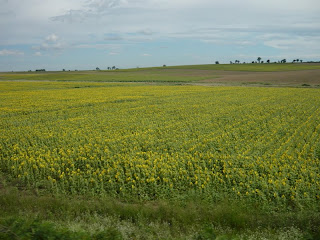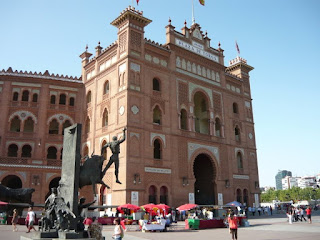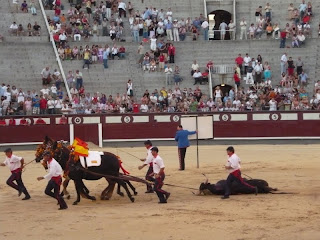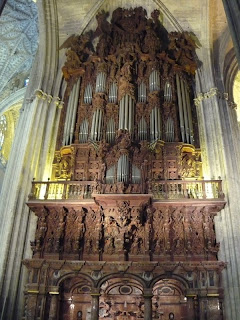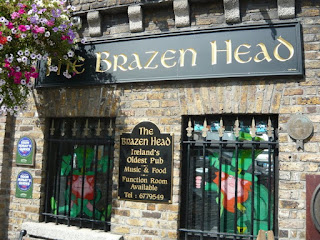I took the bus to the Dublin International Airport. The guy at the security counter in Dulin said he had never seen a passport as marked up as mine. I have to admit I'm a bit proud of all the ink on my passport.
I slept pretty well on the plane on the way from Dublin to Chicago. I didn't have time to get philosophical about being on American soil or kiss the ground like the Pope does. I only had an hour and a half to deboard plane, get through Customs and Immigration, go through security, and get to the gate for my connecting flight to Nashville. The Immigration officer asked me where I'd been and I told him I'd been to about 30 countries. He then asked me to name them. So I rattled off a recount of my travels that I had done hundreds of times to fellow travelers. That was the first time it occurred to me that maybe I should have booked a ticket with a longer layover. I had been to places like Colombia, Bolivia, Cambodia, Kosovo, etc., that could possibly seem suspicious. I had a party to get to and really didn't want to miss my connecting flight. After listing off my countries, he asked if I had been to Pakistan, Afghanistan, or Cuba. I told him I had not. He then stamped the last tiny bit of blank real estate left on my passport and I hurried along through security and to my connecting gate. The plane was already starting to board by the time I got there.
I was struck by how it didn't seem like any time had passed. Flying in to the Nashville airport felt like coming back from any domestic work or leisure trip. My mom, sister, niece and nephew were there to greet me. Leaving the airport and traveling on I-40 and I-440 was really weird in that it seemed like my trip, even the most recent parts, were a distant memory. There was new building on the Nashville skyline. The Gulch looked different. But Nashville looked mostly the same as I left it, even if I looked different. I lost about 45 pounds and grew about 6-7 inches of hair while I was gone. I was kind of surprised my niece and nephew recognized me right away.

I went to the Outback for a sort of coming back party. About 20 or so friends showed up. It was so good to see everyone again. Even though I hadn't seen anyone in a year, it seemed like no time had passed and I picked up right where I left off. Huge thanks to everyone who made it out.
I'd like to give a shout out to a few people:
1. My family - for not freaking out too bad about me quitting my job and traveling for a year to a lot of places that are perceived as being dangerous. Or at least not letting me know they were freaked out.
2. Greg "The Beast" Overby - for taking care of my mail and scanning and emailing a bunch of stuff to me. It was a thankless, unrewarding job, but someone had to do it.
3. Heather, Jen, and Jason - for meeting up with me in Costa Rica. A lot of people said they come see me on my trip, but only they were truly game.
4. Everyone who read my blog and posted comments or sent me messages about the goings on back home - I guess it's the modern day version of getting letters from home, and they meant a lot.
5. Everyone I met along the way - far too many people to name. If I hung out for a few weeks, a few days, or even a few hours with you on my trip, I really enjoyed the time we shared. I really wish I had done a better job documenting the people I met and the conversations I had.
Have I changed any as a person since I started the trip? I don't think I've changed to any great extent. I'm in my mid 30's and I think who I am is pretty set at this point. If I had done this trip 10 or 15 years ago I think I might have a different answer. I think that maybe by doing it at a younger age maybe I would have gotten to be who I am earlier maybe? I am happy with the physical change though. I hope I can keep off the weight I've lost. It would be really nice to go as The Dude next Halloween instead of as Walter.
I have a few bits of advice for anyone thinking about doing something like this. People tell me all the time that I'm really lucky to have had this experience. I don't like to think of it as luck so much, but luck probably did play a part to some extent. I tell people, only half-jokingly, that they need to work hard, save money, and don't get married. If I was seriously giving advice, It would be first and foremost you need to be debt free and have a good bit of money saved up. Not to get all Dave Ramsey on everyone, but having money and zero debt is absolutely necessary to do a trip like this. The second thing is that you really have to want it. Quitting a job and traveling a year is not a decision that one can come to rationally. I was quite obsessed with making this trip. I had a globe and a world map in my office at work. I had a atlas above my fireplace at home. When I daydreamed, I daydreamed of traveling and specifically I dreamed of this trip. It made no financial sense whatsoever, but I did it anyway. Third and lastly, anyone doing this kind of trip must be sociable and be able to make new friends easily, but also be comfortable with spending time alone. You will get to a foreign country. You'll be all by you yourself, and it's going to really freak you out. But there are lots of people out there in the same boat as you.
The theory of diminishing returns that I learned in college economics proved to be true on this trip. A year is a long time to travel. Although I've seen a lot, there are still many more places I haven't seen. I haven't been to Japan, China, Russia, Nepal, New Zeland, most of Africa, and much of central America and Mexico. Yet, getting anything else in on this trip would have been wasted. I had had my fill and was ready to come home.
Three questions about the trip I get the most are a) what was my favorite place, b) did I feel safe, and c) how were the hostels.
a) I really enjoyed all the places I went. It's hard to say what I like the best. But if I had to list three places that exceeded my expectations, they would be Colombia, Laos, and Bosnia. None of these countries were high on my radar screen. None had a marquee sight like a Taj Mahal, a Machu Picchu, or an Angkor Wat. But there was something special about these places and I think they will be the hot new places for tourists in the coming years.
b) If you believe what you see on movies, TV, and even the news, you would think the world is this horribly dangerous place, and that is just not the case. If you believe movies like Hostel or Turistas, the moment a foreigner gets off the bus there's a guy in a car looking at him or her through binoculars and talking on a cell phone with his organ harvesting/kidnapping partner. The biggest thing I worried about was petty crime, i.e., my backpack or wallet getting stolen. As readers of this blog will no doubt know, my backpack was stolen twice and my wallet stolen once. I met several people who were robbed, but these robberies were mostly late at night and they didn't lose huge amounts of money. I would have lost a lot less money and valuables if I had been robbed coming home from a bar or club late at night.
Having said that, there was one instance early in the trip in Panama City. It was the day before Thanksgiving and I had just arrived from Bocas del Toro and was flying to Medellin, Colombia the next day. I walked down the street from my hostel to a local market to get lunch and a new pair of flip flops. On my way back, there was a big crowd gathered on the street. As I made my way through the crowd, I noticed bullet holes in the glass of a building. I turned around and saw a body laying on the ground. He had been shot and was laying face down, likely dead. He looked like he might have been a teenager, but I couldn't really tell since he was face down. I actually had my camera with me but thought it would be unwise to start snapping pictures.
c) Are hostles ok? Yeah. If you're not too high maintenance. At one place the showers had translucent dividers between the coed showers. It wasn't very clear. I could tell there was a body in the next stall over, but I couldn't really see much detail. I really couldn't tell whether it was a man or a woman. I made the comment to some other people at the hostel that Europeans were more comfortable with nudity and that shower set-up would never fly in America. They thought I was kidding. They assumed from watching reality shows that all Americans were quick to get naked in public. But by and large the hostels were clean and a great way to meet fellow travelers of all ages.
There are a lot of small differences in English among Brits, Ozzies, and Americans. A trunk of a car is a boot, a jacket is a jumper, pants are trousers, sneakers are trainers, and cigarettes are fags. It is very common for an Englishman to say, "I'm stepping outside to have a fag." In Australia, root means to have sex. So if you say you root for the home team, Aussies would think you to be a dedicated fan.
I didn't buy any souvenirs to speak of. I had replaced most of my clothes during the trip either because they had worn out or because they had gotten too big. I did have a suit custom tailored in Bangkok. It fit me perfectly in April 2009, but now the pants are a bit too loose and the coat is a bit too snug. But I didn't buy any real souvenirs. I couldn't carry then in my backpack. Shipping stuff home would have been expensive and iffy. Now that I'm back, I kind of wish I had bought a few pieces of artwork. It would be kind of cool if I had bought a painting from that artist in the favela in Rio. I also would have liked some works I saw at this little market in Vietnam. These would have made infinitely better conversation pieces than something I bought at IKEA or Target.
OK. So I've been home since August. It's now February. You may be thinking, "Why has this taken so long and what have I been doing?" The reason it's taken me so long to write the last few posts and the trip wrap-up is because I didn't really know how the story was going to end. The story couldn't end with me being 37 years old, unemployed, and living with my parents. Also, it felt less weird to write posts when I was away and anyone reading them would be thousands of miles away.
When I got home, my intention was to spend a couple of months at home and then get a job and start graduate school. I was accepted into the MHA program at the University of Washington. After three months of looking for a job out there and getting absolutely no responses, I had second thoughts. The plan was to work and go to school. But the prospect of a $7,000 tuition and fees bill with no money coming in was pretty daunting. I went out to the first weekend class meeting, and after talking to fellow students about the local economy, I felt even worse about my prospects of finding a job in the Pacific Northwest. I decided to leave the program in time to get my tuition refund and open my job search nationwide.
Apparently a recession came while I was gone. It has taken a lot longer to find a job than I had imagined. But I've finally found a job at a hospital in Pennsylvania, outside of Philadelphia. I start February 15.
I have enjoyed writing about my trip. I hope you have enjoyed as well. My life will be exponentially less interesting going forward.
I hope every one has enjoyed reading my blog. I had a blast writing it.
Jay





















